

Agility before, during and after the COVID crisis. Before the COVID-19 pandemic, agility was already a highly-prized leadership asset.

Agile leaders can develop agile teams that, in turn, create agile businesses. Agile businesses tend to be more innovative, better at meeting customer needs and more productive. Achieving Organizational Agility, Intelligence, and Resilience Through Information Systems (10 September 2021) by Hakikur Rahman. Organizational Agility Manifesto - Information Flow. Organisational Agility Explained. Exploiting Agility for Advantage: A Step-by-Step Process for Acquiring Requisite Organisational Agility (7 Septembre 2021) by David L. Francis. Organizational Agility 101: Achieve Organisational Agility By Adopting The OA Framework: Books On Scrum And Agile (21 August 2021) by Sterling Wehby.
Organizational Agility Unleashed: Getting Work Done in an Increasingly Complex Digital World (13 July 2021) by Jim Grundner, Kimberly Andrikaitis, Bob Galen and DeAnna Burghart. Resetting Management: Thrive with Agility in the Age of Uncertainty (29 June2021) by Stéphane J. G. Girod and Martin Králik. Agile advantages. June 14, 2021When the pandemic forced businesses to close their doors to foot traffic, industries such as utilities and insurance saw a boost of as much as 46 percent in consumer engagement with their digital channel offerings.
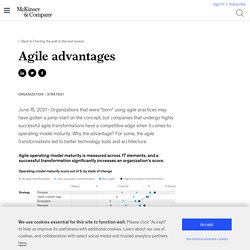
But grocery shoppers want to pick their own produce again, leading to a drop in engagement with grocers’ digital channels of about 17 percent. Some industries in the European Union also saw declines in digital adoption, particularly among banking, retail, and telco carriers. We strive to provide individuals with disabilities equal access to our website. Agile Organizations. Report: The impact of agility: How to shape your organization to compete. Special Report Infographic: Getting agile transformations right Agility is on everyone’s lips—online searches for “agile transformation” yield around 100 million hits, and the stories of well-known pioneers circulate widely.
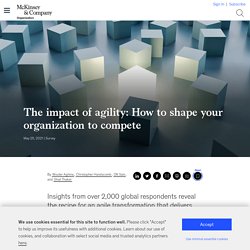
But is this just hype, or are there real benefits to be gained? Is agility just noise from the IT department, or an opportunity that merits serious attention from the top team? And if pursuing agility yields benefits, what is the recipe for success? To find the answers, we conducted a McKinsey Global Survey that reached 2,190 respondents across industries and geographies. Their organizations fell into two broad groups: the first group consisted of organizations with no agile transformation efforts in process; the second group consisted of organizations on the move, pursuing, or having recently completed an agile transformation beyond a few individual teams (see sidebar “Organizations are on the move”).
Better, Faster, Stronger: Organizational Agility Over the Last 5 Years. What is Organizational Agility: A Conversation with Chris Worley. Agility is work's new superpower. Organizational Agility A Complete Guide - 2021 Edition (10 November 2020) by The Art of Service - Organizational Agility Publishing. Organizational Agility Unleashed: Getting Work Done in an Increasingly Complex Digital World (2020) by Jim Grundner, Kimberly Andrikaitis, Bob Galen and DeAnna Burghart. Sooner Safer Happier: Patterns and Antipatterns for Organizational Agility (Oct 2020) by Jonathan Smart. On demand webinar: Organizational Agility. Becoming an All-Weather Company. Here we explore some specific measures that resilient companies deploy to operationalize the six principles.
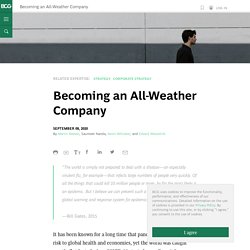
Prudence Prudence involves operating on the precautionary principle that if something can plausibly happen, it eventually will. Prudent companies therefore have an anticipation advantage, which helps them be better prepared to manage a crisis. Resilient companies operationalize prudence by preparing for long-term shifts that can significantly disrupt an industry, developing plans or circumvention mechanisms in anticipation of a disruption, and looking for early warning signals to identify a crisis before it affects them. Organizational Agility Unleashed: Getting Work Done in an Increasingly Complex Digital World (13 July 2020) by Kimberly Andrikaitis and Bob Galen. L'organisation agile.
Harnessing the Power of Being an Agile Organization. Répondre. Rebondir. Réinventer. Respond. Rebound. Reinvent. L' agilité organisationnelle comme une priorité selon le Baromètre mondial CGI 2020. L'organisation en mouvement: Adopter le changement permanent (2020) par Éric Delavallée. Transformer son organisation: Alignement stratégique et agilité organisationnelle : 6 principes opérationnels (2016) par Éric Delavallée. Structural Agility - Using structure to enable the flow of value. Author: Jardena London Key Contributors: Sally Parker, Nadezhda Belousova and Laurie Reuben Editor: Chris Hayes-Kossman How can Structure help your business achieve true Agility, and survive the challenges posed by the changing environment?
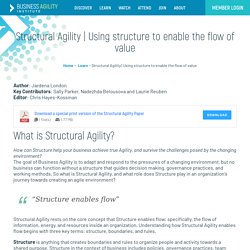
The goal of Business Agility is to adapt and respond to the pressures of a changing environment, but no business can function without a structure that guides decision making, governance practices, and working methods. So what is Structural Agility, and what role does Structure play in an organization’s journey towards creating an agile environment? “Structure enables flow” Structural Agility rests on the core concept that Structure enables flow; specifically, the flow of information, energy, and resources inside an organization. Structure is anything that creates boundaries and rules to organize people and activity towards a shared purpose. When the Ground Shifts, It Pays to Be Agile. The companies that emerge stronger from the COVID-19 crisis will be the ones that address three critical factors in the coming months: cost, speed, and resilience.

For many companies, the need to reduce costs while doing minimal harm to key capabilities is axiomatic. Revenues, profits, and cash flows are plummeting. If costs don’t follow suit, dire consequences are inevitable. The ability to react quickly to changed circumstances will have a major impact on companies’ ability to contain the damage and make the most of new opportunities. For example, BCG’s retail banking research found that since the crisis struck, the use of digital channels in Italy, the US, and the UK increased by 33%, 20%, and 14%, respectively. La plus belle des intersections. Mario Andretti. Organizational Agility Unleashed: Getting Work Done in an Increasingly Complex Digital World (July 2020) by Jim Grundner, Kimberly Andrikaitis, Bob Galen and DeAnna Burghart. Organizational Agility and Why It's Important.
The Strategic Agility Institute™ What Is This All For? Report: Organisational agility: How business can survive and thrive in turbulent times. The New Competitive Divide: Organizational Agility. Organizational Agility: The New Competitive Edge in a Rebound. Survive + Thrive. Activating the Thrive Channel Aggressively activated Thrive Channels have the potential to drive behavior which can execute innovative strategic initiatives (which always have elements of some risk) despite regulatory requirements (which demand risk mitigation).
These channels can help find and execute new competitive initiatives despite cultures shaped to believe they do not have to compete much or even think in terms of competition. They can keep strategic attention on disruptive possibilities despite the 90-day financial reporting cycle. Compass for Agility: Organizational Value Realized (2020) by Leila Rao. Strategy+business. Every organization today may find itself heading toward an abrupt environmental shift that poses an existential threat, a transformational opportunity, or both.

The disruption already happening across all domains is staggering, and it’s picking up speed. But leaders confronting such changes start at a disadvantage. Evolution has endowed humans with traits that don’t mix well with complexity and uncertainty, as such environments tend to make people risk-averse, either impulsive or reluctant to act, and focused on fending off dangers.
The changeable organization. What are the opportunities organizational agility can create. Compass for Agility: Organizational Value Realized (2019) by Leila Rao. Achieving Vitality in Turbulent Times. Build the right capabilities.
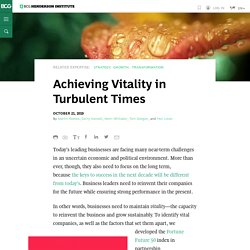
To deliver on their growth potential, businesses need to build a range of dynamic capabilities. These include technological excellence (even for companies that are not in traditional digital sectors), a diverse workforce with a culture that encourages the collision of ideas, and the organizational capacity to self-disrupt before being disrupted from the outside. Visa (number 43) stands out as one of the oldest and most-established companies in the Fortune Future 50. Attributes of an Agile Organization. The Declaration of our Interdependence. Attributes of an Agile Organization. The Infinite Game - 4. Existential Flexibility - THE 5 PRACTICES. Is Your Organization "Sort of" Agile? At least once a week, we stand in front of a room of executives, leaders, managers and practitioners and ask the question, “How many of you work in an Agile way?”

Without fail, 99% of the hands in the room go up. The other 1%, the honest ones, raise their hand halfway and wave it side to side indicating that they are “sort of” Agile. The infnite game - Worthy Rival. The infinite game - Trusting Teams. The Agility Shift. Simon Sinek: The Best Way to Run a Business Is Without an End Goal in Mind. Simon Sinek got famous answering a question with a question.

The first question, posed by company leaders, was, "How do I inspire employees and customers, day after day, even beyond their appreciation of what my business does? " The author and motivational speaker's answer--also the title of his first book--was "Start with why. " People will be motivated, he explained, when they understand the fundamental reason that you do what you do. Fast and modular - Five Fifty. Why Does Agility Matter for Business Success? Organizational Agility: How to Succeed in Business in 2018 & Beyond. If there is any certainty, it is this: no organization can survive - let alone thrive - if it is unable to adapt to the changing circumstances it operates in.
Successful organizations are agile; able to anticipate and respond to trends, change quickly while innovating, and continuing to delight their customers. Can anyone doubt that we are living through turbulent times? Across the world, there are shifting tectonic plates of political opinion, including polarisation and growing feelings of anti-globalization. Brexit is but one illustration of the tendency of those who feel they have not reaped the full benefits of globalization to resort to bunker mentality and say 'no' to participating in deepening European integration. As a result, marketplaces and sources of profitability are being transformed with consequences which are hard to predict. Companies are not immune to environmental pressures for change either. Why I Wrote The Infinite Game.
The Infinite Game (2019) by Simon Sinek. Organizational Agility A Clear and Concise Reference (2018) by Gerardus Blokdyk. Agile Admissions. The company of the future. Unlocking continuous human learning capabilities. As humans increasingly focus on higher-level thinking, they will need to learn and practice new skills. This shift will not be “one-shot” learning—the required abilities will continue to evolve unpredictably. Learning will therefore need to be embedded in the workflow, and responsive to changing needs, rather than being batched at the beginning of careers. Organizations will also need to invest in “learning contracts” with employees, mutually committing to continuously develop new skills for new roles. Organisational agility is the key to going further, faster. The New Competitive Divide: The foundational building blocks of organizational agility. The One Thing You Need to Know About Organizational Agility.
The Organization of the Future. Unlocking continuous human learning capabilities. As humans increasingly focus on higher-level thinking, they will need to learn and practice new skills. This shift will not be “one-shot” learning—the required abilities will continue to evolve unpredictably. Learning will therefore need to be embedded in the workflow, and responsive to changing needs, rather than being batched at the beginning of careers. Organizations will also need to invest in “learning contracts” with employees, mutually committing to continuously develop new skills for new roles.
Leading in ecosystems. Orchestrating an adaptive organization. Networks + Hierarchies eBook. Disrupt or be disrupted. That’s the world businesses and organizations around the world are operating in today. Is your organization able to react and adapt to the constantly shifting landscape? Organizational Agility Project All-Inclusive Self-Assessment - More than 660 Success Criteria, Instant Visual Insights, Comprehensive Spreadsheet Dashboard, Auto-Prioritized for Quick Results (2019) by The Art of Service.
Are Businesses Worldwide Suffering From a Trust Crisis? Story Highlights. Top of mind: A view on Davos 2019. Globalization 4.0 - what does it mean? After World War II, the international community came together to build a shared future. Agile Organizations. Enterprise Agility: Being Agile In a Changing World (2018) by Sunil Mundra. How to make your organisation more agile. Enterprise Agility 2017. Trend 2: Organizational Agility – Agility Scales. Simplicity, Synergy, and Scale. One of the world’s most venerable business organizations is celebrating its 150th anniversary this year, and the challenges it faces today are the same, in many ways, as those it faced at its beginnings.
Then, its entrepreneurial founder started businesses across a variety of emerging industrial sectors; now, the group includes a diverse portfolio of companies, 30 of which are publicly listed, under a single holding company — Tata Sons — headquartered in Mumbai. From its Indian roots, Tata has evolved into a global powerhouse in multiple industries, with two main goals. On the one hand, it is fiercely oriented toward shareholder value: It has an aggregate market capitalization of more than US$160 billion and 4 million shareholders. On the other, it is a community-oriented company, with more than 60 percent of shares held by a set of philanthropic trusts that fund health, education, and development in the communities where it conducts business.
Related Stories. This is the Age of Agility. The Case Against Agility. Leadership has always required the willingness to move in directions that peers avoid. Great leaders have the ability to convince, or induce, others to follow. Apple Inc. cofounder Steve Jobs, for instance, stared down the derision of analysts and peers when he first opened Apple retail stores.
Those outlets attracted millions of consumers who were new to the brand and have achieved the highest retail sales rates ($5,546 per square foot in 2016) of any retail brand. Microsoft and Sony followed Apple’s lead with brand-specific technology retail stores. Organizational Agility: How to Succeed in Business in 2018 & Beyond. Bureaucracy Can Drain Your Company’s Energy. Agile Can Restore It. BCG The Playful Corporation Apr 2018 tcm9 190718. How to perform like a start-up. Taking the measure of innovation with conversion metrics. The path to agility: a staged approach. March 30, 2018 – by Wouter Aghina, Karin Ahlbäck and Allan Jaenicke Peter Drucker pinpointed five essential questions to ask about any organization. He recognized that the answers provide a stepping stone for probing deeper to truly understand an organization.
The importance of questioning holds true on the journey to become Agile, which involves four distinct stages: agile foundations, experimentation, scale-up and continuous evolution. Defining True Sustainability. Most companies have not yet come to terms with what it means to be truly sustainable. The signs are clear: Sustainability is a key corporate priority. How to mess up your agile transformation in seven easy (mis)steps. Why competitors will have to cooperate for the factory of the future - Digital transformation at DMG MORI ᐅ Interview with Christian Thönes.
Lessons From the Maker Movement. The 2% Company. Manifesto — Responsive.org. The inner war of the revolutionary - Ron A. Carucci. The Flare and Focus of Successful Futurists. The Case Against Agility. Organizational Agility: Thriving in a State of Constant Change. How Vital Companies Think, Act, and Thrive. Building the critical foundation of an agile organization.
Scaling up organizational agility. Enterprise Agility 2017 - Raconteur. Focusing on What 90% of Businesses Do Now Is a Big Mistake.